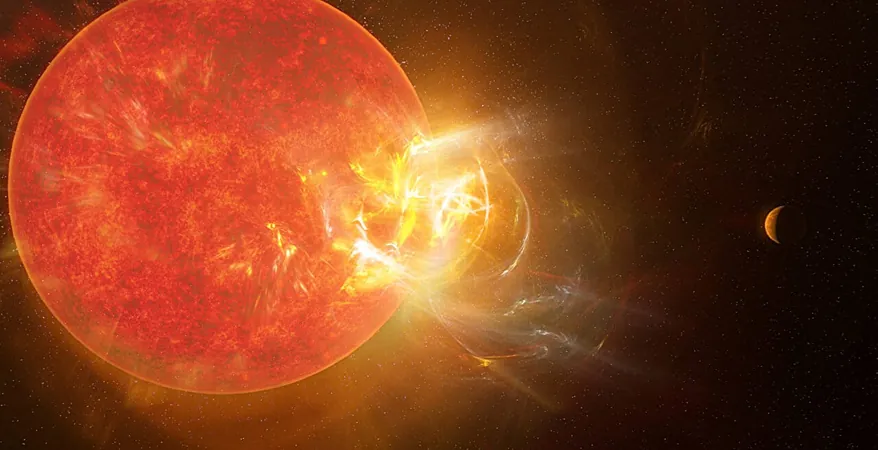
Astounding Cosmic Discovery: ALMA Detects Record-Breaking Flares from Proxima Centauri
2025-03-29
Author: Ting
In an astonishing revelation just over four light-years away from Earth, astronomers using the Atacama Large Millimeter/submillimeter Array (ALMA) have captured the most intense flare ever recorded from Proxima Centauri, our nearest stellar neighbor. This groundbreaking study, recently published in The Astrophysical Journal, provides unprecedented insight into the fierce energy bursts that small stars can emit.
Despite being categorized as a red dwarf—significantly smaller and cooler than our Sun—Proxima Centauri has displayed a remarkable level of activity. This latest powerful flare raises important questions about the habitability of nearby exoplanets and serves as a vivid illustration of the unpredictable nature of stellar evolution.
Proxima Centauri: A Volatile Neighbor in Our Cosmic Neighborhood
Proxima Centauri, located a mere 4.2 light-years away, has piqued the interest of astronomers for years. Notably, the star hosts Proxima b, a rocky exoplanet situated in its habitable zone. However, this relatively Earth-like world could be facing dire challenges due to the instability of its parent star.
Recent observations have revealed that Proxima Centauri frequently unleashes short, yet extremely powerful flares, releasing up to 10²⁷ ergs of energy in just a few seconds. These massive energy bursts, detected in radio and millimeter wavelengths, possess the capability to strip away planetary atmospheres, severely jeopardizing the potential for life.
As stated by co-author Meredith MacGregor from Johns Hopkins University: "Our Sun’s activity doesn’t remove Earth’s atmosphere due to its thick protective layer and robust magnetic field. In contrast, the flares from Proxima Centauri are more potent, and we are left wondering: what implications do they have for the atmospheres of rocky planets in close orbit?"
Unraveling the Secrets of Stellar Activity
Unlike conventional optical studies, ALMA enables astronomers to observe Proxima Centauri in radio and millimeter wavelengths, revealing energetic outbursts often overlooked by visible-light telescopes. In an extensive data collection spanning over 50 hours, the team discovered 463 flare events, ranging from gentle flickers to devastating bursts that lasted between 3 to 16 seconds.
"When we're observing flares with ALMA, we're witnessing electromagnetic radiation across different wavelengths," MacGregor explained. "This radio flaring also helps us understand the behavior of particles emitted from the star, adding a layer of depth to our observations."
The research indicated that the millimeter-wavelength flares follow a distinct power-law distribution when compared to optical flares, implying that Proxima Centauri's activity is likely more extreme than scientists had originally predicted.
A New Understanding of Stellar Flares
A notable finding was the asymmetrical nature of the most significant flares. Researchers noted that the decay phase—where energy gradually dissipates—was prolonged compared to the initial outburst. Such behavior suggests intricate magnetic interactions occurring beneath the surface of the star.
Proxima Centauri operates on a fully convective structure, where its entire interior resembles a boiling pot, resulting in intense magnetic fields that twist and tangle before releasing explosive flares. This complex nature contributes to Proxima's higher level of activity compared to our Sun.
"The frequency of millimeter flaring is substantially higher; without looking exclusively at optical wavelengths, we risk missing critical phenomena," MacGregor asserted. "ALMA is currently the only millimeter interferometer capable of capturing these essential measurements."
Implications for Proxima b's Potential for Life
Proxima b, the Earth-like planet orbiting within the habitable zone of this volatile star, has long been considered one of the most promising candidates harboring extraterrestrial life. Nevertheless, the discovery of frequent and powerful flare activity now poses serious questions regarding its habitability.
Should Proxima Centauri's potent flares impact Proxima b, they might erode the planet's ozone layer, strip away water vapor, and expose the surface to harmful radiation—unless Proxima b possesses its own strong magnetic field and dense atmosphere.
While this study does not entirely dismiss the possibility of life, it does significantly alter our understanding of the risks involved. What previously seemed like a friendly neighborhood star now appears as a potentially hazardous source of radiation.




 Brasil (PT)
Brasil (PT)
 Canada (EN)
Canada (EN)
 Chile (ES)
Chile (ES)
 Česko (CS)
Česko (CS)
 대한민국 (KO)
대한민국 (KO)
 España (ES)
España (ES)
 France (FR)
France (FR)
 Hong Kong (EN)
Hong Kong (EN)
 Italia (IT)
Italia (IT)
 日本 (JA)
日本 (JA)
 Magyarország (HU)
Magyarország (HU)
 Norge (NO)
Norge (NO)
 Polska (PL)
Polska (PL)
 Schweiz (DE)
Schweiz (DE)
 Singapore (EN)
Singapore (EN)
 Sverige (SV)
Sverige (SV)
 Suomi (FI)
Suomi (FI)
 Türkiye (TR)
Türkiye (TR)
 الإمارات العربية المتحدة (AR)
الإمارات العربية المتحدة (AR)